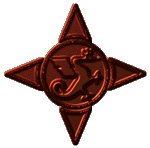


On the right side of the drawbridge stands the statue of the famous Lady Carcas. At first glance you would think it is a very modern interpretation of the myth of this Lady with a strong personality. But this bust is very old actually. The one you see today is just a recent but faithful reconstruction of the true one dating back from the 16th century.
It has been put here by the inhabitants of the Cité and symbolized their dissatisfaction against the transfer of administrative powers to the Lower Town. The inscription "Sum Carcas" (I am Carcas) in fact meant that Carcassonne was here, in the Cité, and not below in the Lower Town, which was considered as a village, a suburb near the Cité.
The ditch under the bridge never contained water, as some people say today. First, it is impossible just because the Cité is on the top of a hill ! Water in Carcassonne obeys the basic laws of gravity. Try to pour water into this ditch, it won't stay there for a long time !!!
Secondly, water in a dry region like ours is a very precious good, and nobody would be so stupid as to waste it and pour it into a ditch. In the Middle Ages, people needed it just like today to drink and wash !
So you can forget the deep and dark moats around the walls...
Impressive, magnificent, majestic, ...
A heap of adjectives can apply to the Narbonne's Gate and the neighbouring Tour du Trésau (Treasure Tower). It is sure that during the Middle Ages, foreigners arriving in Carcassonne were terribly impressed by these stone giants.We still feel the same today !
This Triumph Gate dates back from the reign of King Philippe III (around 1280 - 1290).
It is not just a city gate, but a very complete defence system built in a spur shape : murder holes perfectly adapted to crossbow archery, a chain blocking the entrance, a machicolation, hoardings, a heavy portcullis, a door strengthened with wooden bars. The whole of this system is repeated behind (machicolation, portcullis, door...) in case the enemy would manage to pass the first obstacles.
The inhabitants decided to destroy the gate in the 1820s, because the ceiling threatened to collapse. But it was splendidly restored by Viollet-le-Duc.
Access into the twin towers is free.
On the left there is a room containing a fascinating model of the Cité. On the right there is the Tourist Information Office. The enormous hole in the middle of the room was used as a cistern, never as a dungeon !!
we are really sorry, but we have to wipe out some false assertions we very often hear or read about the Cité !!
